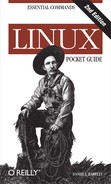df
|
Display available space on mounted filesystems. |
mount
|
Make a disk partition accessible. |
umount
|
Unmount a disk partition (make it inaccessible). |
fsck
|
Check a disk partition for errors. |
sync
|
Flush all disk caches to disk. |
Linux systems can have multiple disks or disk partitions. In casual conversation, these are variously called disks, partitions, filesystems, volumes, even directories. We’ll try to be more accurate.
A disk is a hardware device, which may be divided into partitions that act as independent storage devices. Partitions are represented on Linux systems as special files in (usually) the directory /dev. For example, /dev/sda7 could be a partition on your hard drive. Some common devices in /dev are:
|
hda |
First IDE bus, master device; partitions are hda1, hda2, ... |
|
hdb |
First IDE bus, slave device; partitions are hdb1, hdb2, ... |
|
hdc |
Second IDE bus, master device; partitions are hdc1, hdc2, ... |
|
hdd |
Second IDE bus, slave device; partitions are hdd1, hdd2, ... |
|
sda |
First block device, such as SCSI, SATA, USB, or Firewire hard drives; partitions are sda1, sda2, ... |
|
sdb |
Second block device; partitions are sdb1, sdb2, ... Likewise for sdc, sdd, ... |
|
ht0 |
First IDE tape drive (then ht1, ht2, ...) with auto-rewind |
|
nht0 |
First IDE tape drive (then nht1, nht2, ...) without auto-rewind |
|
st0 |
First SCSI tape drive (then st1, st2, ...) |
|
scd0 |
First SCSI CD-ROM drive (then scd1, scd2, ...) |
|
fd0 |
First floppy drive (then fd1, fd2, ...), usually mounted on /mnt/floppy |
Before a partition can hold files, it is “formatted” by a program that writes a filesystem on it (see Partitioning and Formatting). A filesystem defines how files are represented; examples are ext3 (a Linux journaling filesystem) and ntfs (Microsoft Windows NT filesystem). Formatting is generally done for you when you install Linux.
Once a filesystem is created, you can make it available for use by mounting it on an empty directory. For example, if you mount a Windows filesystem on a directory /mnt/win, it becomes part of your system’s directory tree, and you can create and edit files like /mnt/win/myfile. Mounting is generally done automatically at boot time. Filesystems can also be unmounted to make them inaccessible via the filesystem, say, for maintenance.
